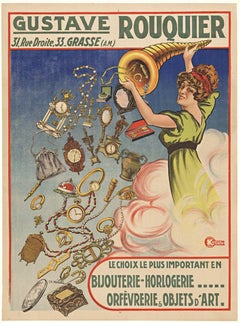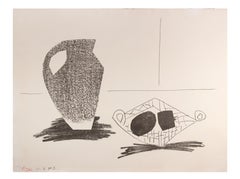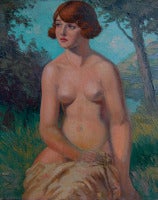Charles Naillod Art
to
1
1
Overall Width
to
Overall Height
to
1
1
1
1
1
1
1
1
1
1
1
9,989
2,754
1,378
1,375
1
Artist: Charles Naillod
Original Gustave Rouquier Bijouterie - jewelry art nouveau vintage poster
By Charles Naillod
Located in Spokane, WA
Original turn of the century French poster: Gustave Rouquier turn of the century stone lithograph for jewelry. Artist: Charles Naillod. Size: 47" x 63". "The most important choice in jewelry, watches, and goldsmith objects". This antique art nouveau authentic vintage poster...
Category
Early 1900s Art Nouveau Charles Naillod Art
Materials
Lithograph
Related Items
Iris
By Gary Bukovnik
Located in San Francisco, CA
This artwork titled "Iris" 1998 is an original color lithograph on Wove paper by noted American artist Gary Bukovnik, born 1947. It is hand signed, dated and numbered 109/200 in pencil by the artist. The image size is 10 x 9.75 inches, sheet size is 14.75 x 13.5 inches. It is in excellent condition, the colors are fresh and bright, has never been framed.
About the artist.
Born and educated in Cleveland Gary Bukovnik has lived in San Francisco for over 25 years. Primarily using the mediums of watercolor, monotype, and lithograph, Bukovnik creating colorful floral images of great depth and intensity.
Bukovnik collaborates with Trillium Press, whose owner and master printer, David Salgado, studied at the Tamarind Workshop, formerly in Los Angeles.
In 2003, the American Academy in Rome invited Bukovnik to attend the academy as a Visiting Artist for six weeks. He was asked to attend a second session in February 2005. In 2001, he was selected to create a poster for the prestigious List Collection, which creates posters to commemorate programs at Lincoln Center for the Performing Arts in New York. Lincoln Center past contributors have included Roy Lichtenstein, Andy Warhol, Robert Motherwell, Helen Frankenthaler, Alex Katz, Elizabeth Murray, and Donald Sultan. The work of Gary Bukovnik is held in public and private collections worldwide.
Selected Museums
Art Gallery of Hamilton, Ontario The Art Institute of Chicago Atlanta Botanical Garden Brooklyn Museum
Brooks Museum of Art, Memphis
The Butler Institute of American Art, Youngstown Dallas Museum of Art
Fine Arts Museums of San Francisco
Frye Art Museum, Seattle
Hunt Institute for Botanical Documentation, Carnegie Mellon University, Pittsburgh
Hunterian Art Gallery, University of Glasgow
Library of Congress, Washington, DC
The Metropolitan Museum of Art, New York
The Minneapolis Institute of Arts, Minnesota Museum of Fine Arts, Boston
The Museum of Modern Art, New York
The Richard L. Nelson Gallery, U.C. Davis, California The New York Public Library
Oakland Museum of California
Philadelphia Museum of Art
Phoenix Art Museum
Portland Art Museum, Oregon
Rhode Island School of Design Museum, Providence San Francisco Museum of Modern Art
University of Arizona Museum of Art, Tucson University of California, Berkeley Art Museum
Selected public collections
ALZA Corporation, Mountain View
ART In Embassies Program, U.S. Department of State
AT&T, New York
Atlantic Richfield, Los Angeles
BankAmerica Corporation, Charlotte
Citigroup, New York
Cleveland Institute of Music
Clorox Company, Oakland
Comerica Bank, Costa Mesa & San Jose
H.J. Heinz Company, Pittsburgh
Illinois Bell Telephone...
Category
Mid-20th Century American Realist Charles Naillod Art
Materials
Lithograph
Nature Morte au Pot de Grès - Lithograph by Pablo Picasso - 1947
By Pablo Picasso
Located in Roma, IT
Hand signed in red pencil and numbered. Dated in plate.
Edition 14/50. On Arches Wove Paper.
Excellent condition.
Reference: Bloch n.443; Mourlot 86.
Category
1940s Cubist Charles Naillod Art
Materials
Paper, Lithograph
$14,905
H 19.69 in W 25.6 in D 0.04 in
Metropolitan Opera Centennial 1883-1983 lithographic poster A Heart at the Opera
By Jim Dine
Located in New York, NY
Jim Dine
Metropolitan Opera Centennial 1883-1983 poster, 1983
Offset lithograph poster; unsigned
46 × 29 inches
Unframed
This limited edition poster was pu...
Category
1980s Pop Art Charles Naillod Art
Materials
Lithograph, Offset
Unexpected Meetings from the Rilke Portfolio, Minimalist Lithograph by Ben Shahn
By Ben Shahn
Located in Long Island City, NY
Artist: Ben Shahn, American (1898 - 1969)
Title: Unexpected Meetings from the Rilke Portfolio
Year: 1968
Medium: Lithograph on Arches, signed in the plate
Edition: 750
Size: 22.5 x 1...
Category
1960s Modern Charles Naillod Art
Materials
Lithograph
$550
H 22.5 in W 17.75 in
The First Word of Verse Arises from the Rilke Portfolio, lithograph by Ben Shahn
By Ben Shahn
Located in Long Island City, NY
Artist: Ben Shahn, American (1898 - 1969)
Title: The First Word of Verse Arises from the Rilke Portfolio
Year: 1968
Medium: Lithograph on Arches, signed in the plate
Edition: 750
Siz...
Category
1960s Modern Charles Naillod Art
Materials
Lithograph
$550
H 22.5 in W 17.75 in
Nature Morte aux Vases
By René Genis
Located in San Francisco, CA
This artwork titled "Nature Morte aux Vases" c.1980, is an original colors lithograph on wove paper by noted French artist Rene Genis, 1922-2004. It is hand signed and numbered 67/10...
Category
Late 20th Century Impressionist Charles Naillod Art
Materials
Lithograph
The Sea Itself from the Rilke Portfolio, Minimalist Lithograph by Ben Shahn
By Ben Shahn
Located in Long Island City, NY
Artist: Ben Shahn, American (1898 - 1969)
Title: The Sea Itself from the Rilke Portfolio
Year: 1968
Medium: Lithograph on Arches, signed in the plate
Edition: 750
Size: 22.5 x 17.75 ...
Category
1960s Modern Charles Naillod Art
Materials
Lithograph
$750
H 22.5 in W 17.75 in
Watermelon - Lithograph after Renato Guttuso - 1982
By Renato Guttuso
Located in Roma, IT
Watermelon is a mixed colored lithograph by the Sicilian artist Renato Guttuso in 1982
The artwork is from XXeme Siècle Paris/New York; Printer Graphis Arte Livorno/Roma.
Referenc...
Category
1970s Contemporary Charles Naillod Art
Materials
Lithograph
$178 Sale Price
40% Off
H 12.21 in W 17.72 in D 0.08 in
Watermelon - Lithograph after Renato Guttuso - 1982
By Renato Guttuso
Located in Roma, IT
Watermelon is a mixed colored lithograph by the Sicilian artist Renato Guttuso in 1982
The artwork is from XXeme Siècle Paris/New York; Printer Graphis Arte Livorno/Roma.
Referenc...
Category
1970s Contemporary Charles Naillod Art
Materials
Lithograph
$178 Sale Price
40% Off
H 12.21 in W 17.72 in D 0.08 in
Group of seven (7) prints from Engravings of Plants + 1 Redouté
By Abraham Bosse
Located in Middletown, NY
Each a lithograph with hand coloring on watermarked Arches wove paper with a deckle edge. Each 16 1/4 x 12 1/4 (412 x 312 mm); sheet 26 x 19 3/4 inches (661 x 502 mm), each with full...
Category
Late 17th Century French School Charles Naillod Art
Materials
Watercolor, Lithograph
$350
H 16.23 in W 12.29 in
Amaryllis
By Gary Bukovnik
Located in San Francisco, CA
This artwork titled "Amaryllis" 1998 is an original color lithograph on Wove paper by noted American artist Gary Bukovnik, born 1947. It is hand signed, dated and numbered 95/200 in pencil by the artist. The image size is 10 x 9.75 inches, sheet size is 14.75 x 13.5 inches. It is in excellent condition, the colors are fresh and bright, has never been framed.
About the artist.
Born and educated in Cleveland Gary Bukovnik has lived in San Francisco for over 25 years. Primarily using the mediums of watercolor, monotype, and lithograph, Bukovnik creating colorful floral images of great depth and intensity.
Bukovnik collaborates with Trillium Press, whose owner and master printer, David Salgado, studied at the Tamarind Workshop, formerly in Los Angeles.
In 2003, the American Academy in Rome invited Bukovnik to attend the academy as a Visiting Artist for six weeks. He was asked to attend a second session in February 2005. In 2001, he was selected to create a poster for the prestigious List Collection, which creates posters to commemorate programs at Lincoln Center for the Performing Arts in New York. Lincoln Center past contributors have included Roy Lichtenstein, Andy Warhol, Robert Motherwell, Helen Frankenthaler, Alex Katz, Elizabeth Murray, and Donald Sultan. The work of Gary Bukovnik is held in public and private collections worldwide.
Selected Museums
Art Gallery of Hamilton, Ontario The Art Institute of Chicago Atlanta Botanical Garden Brooklyn Museum
Brooks Museum of Art, Memphis
The Butler Institute of American Art, Youngstown Dallas Museum of Art
Fine Arts Museums of San Francisco
Frye Art Museum, Seattle
Hunt Institute for Botanical Documentation, Carnegie Mellon University, Pittsburgh
Hunterian Art Gallery, University of Glasgow
Library of Congress, Washington, DC
The Metropolitan Museum of Art, New York
The Minneapolis Institute of Arts, Minnesota Museum of Fine Arts, Boston
The Museum of Modern Art, New York
The Richard L. Nelson Gallery, U.C. Davis, California The New York Public Library
Oakland Museum of California
Philadelphia Museum of Art
Phoenix Art Museum
Portland Art Museum, Oregon
Rhode Island School of Design Museum, Providence San Francisco Museum of Modern Art
University of Arizona Museum of Art, Tucson University of California, Berkeley Art Museum
Selected public collections
ALZA Corporation, Mountain View
ART In Embassies Program, U.S. Department of State
AT&T, New York
Atlantic Richfield, Los Angeles
BankAmerica Corporation, Charlotte
Citigroup, New York
Cleveland Institute of Music
Clorox Company, Oakland
Comerica Bank, Costa Mesa & San Jose
H.J. Heinz Company, Pittsburgh
Illinois Bell Telephone...
Category
Mid-20th Century American Realist Charles Naillod Art
Materials
Lithograph
Les Caprices Pinces Princiers (Frank Hunter Authenticated)
By Salvador Dalí
Located in Aventura, FL
From Les Diners De Gala. Photo lithograph with a separate original engraving titled Spoon on Crutches. Hand signed by Salvador Dali. Hand numbered 170/395.
Frame size approx 29 x ...
Category
1970s Surrealist Charles Naillod Art
Materials
Paper, Engraving, Lithograph
$1,837 Sale Price
25% Off
H 29 in W 34 in D 1 in
Previously Available Items
Le repos apres le bain
By Charles Naillod
Located in Los Angeles, CA
CHARLES NAILLOD
"NU AU BORD DE LAC"
OIL ON CANVAS, SIGNED
FRANCE, DATED 1925
24 X 20 INCHES
Charles Naillod
B. 1876
Charles Naillod...
Category
Charles Naillod Art
Charles Naillod art for sale on 1stDibs.
Find a wide variety of authentic Charles Naillod art available for sale on 1stDibs. You can also browse by medium to find art by Charles Naillod in lithograph and more. Not every interior allows for large Charles Naillod art, so small editions measuring 47 inches across are available. Customers who are interested in this artist might also find the work of Paul Iribe, Théophile Alexandre Steinlen, and François-Louis Schmied. Charles Naillod art prices can differ depending upon medium, time period and other attributes. On 1stDibs, the price for these items starts at $2,480 and tops out at $2,480, while the average work can sell for $2,480.


